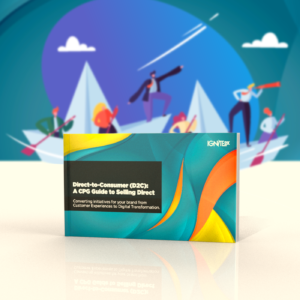Are you looking for a cost-effective way to bring your product or service to market?
Digital transformation is changing industries far and wide. As a result, implementing a Direct-to-Consumer (D2C) strategy is fast becoming a popular way for brands to enter the market directly instead of through a middleman. But, going down the D2C route does not come without its challenges—so we’re sharing the first 10 steps you should take to build a successful D2C strategy.
1. Reexamine Relationships with Customers
In today’s world, every customer is essentially just one tweet away from the CEO. Brands that want to survive in this environment of open-ended dialogue must first work to reexamine their relationships with customers and create transparency. Without crucial investments in technology and culture aimed at strengthening customer relationships, brands risk becoming irrelevant.
2. Define What Your Customers Truly Want
This is the essential question every brand must answer. Brands must view their organization through the customers’ eyes and map their journey from product awareness to post-purchase support. Consider these follow-up questions:
- What motivates customers to move to each next step?
- What barriers do customers encounter at each step in the process?
- How do customers overcome these barriers?
3. Choose the Right Fulfillment Vendors
Freight transport is a critical part of delivering both the product *and* a positive experience that is expected by your customer. Working with a fulfillment vendor allows brands to share freight rates with the total volume of the vendor, rather than the individual brand’s volume. This allows the brand to turn those saving into benefits for their customers, such as a free or reduced shipping rate.
Another variable to consider: How fulfillment can impact product packaging design. Truth be told, many things can happen to the packaged product between shipping to arrival. This requires brands to be more thoughtful and strategic when it comes to packaging design. Reviewing all steps in the fulfillment process when designing packaging can help decrease customer service involvement and prevent a negative customer experience.
4. Develop Your Performance Marketing Strategy
Too often, brands build a D2C website, only to see minimal traffic once launched. Remember, this is not a “build it and they come” scenario. To drive results (and purchases), it is critical that you develop a performance marketing strategy that works in tandem with your website. This should include implementing ecommerce best practices such as clear CTAs, cloud-based product feeds, dynamic product ads, and more. Additionally, understanding how to increase customer lifetime value (LTV) and lower new customer acquisition costs by leveraging data and insights will be a key factor in ROI.
5. Remember Security and Data Protection
One security misstep or data breach can drastically reduce a brand’s trustworthiness in the eyes of the customer. To protect against fraud, brands must combine both an automated and manual approach to data protection. Building in checkpoints to bear the burden of fraud, penalties, and chargebacks will limit your liability, therefore giving you the freedom to focus on building quality products, forming customer relationships, and growing revenue.
6. Integrate Customer Service
Customer service representatives are on the frontlines and will have direct access to customers. This team will need the right training, tools, and information to not only solve the issues, but personalize every interaction and turn a shopper into a raving loyal fan. The customer service team often captures customer insights that are difficult to track anywhere else. Closing the feedback loop between customer service and all ecommerce teams will allow you to proactively address customer concerns, while gaining valuable insights to drive future product or customer experience initiatives.
7. Inform Stakeholders
Many teams are going to cross paths and need to work together. For example, marketing will need to align with the technology department and financing with customer service. Additionally, an outside partner or agency can add another layer to the communication and inner circle. The brand’s team will need to learn how to work across a partner’s specialized ecosystem and collaborate with in-house teams. Your retail partners also need to understand the reasoning behind each initiative to keep all parties on board.
8. Organize Staff Around D2C Objectives
Traditional top-down hierarchical teams simply aren’t nimble enough to survive in the digital age. Smart organizations create cross-functional teams with expertise across a wide range of business processes. For example, some brands are aligning cross-functional teams against specific customer segments in lieu of organizing around traditional marketing capabilities.
9. Evaluate the Customer Experience
98% of first-time visits may not end in a transaction. Your D2C website will require a dedicated web operations team to continuously evaluate the customer experience to meet heightening customer expectations and company goals. The best digital partners will follow industry best practices and employ the most effective tools to ensure the D2C site meets the evolving needs of customers while improving ROI with elevated customer experiences.
10. Find the Right Partner
 Launching a D2C website in a competitive market requires taking planned action and choosing the right digital partner. A digital customer experience company that can build and manage all aspects of the D2C website and system including technical, marketing, customer service, and fulfillment and will help you cut your project timeline. The right partner can also reduce the headaches of managing multiple vendors and technologies for each component of the customer experience. (Not to mention meeting your goals and staying on budget.)
Launching a D2C website in a competitive market requires taking planned action and choosing the right digital partner. A digital customer experience company that can build and manage all aspects of the D2C website and system including technical, marketing, customer service, and fulfillment and will help you cut your project timeline. The right partner can also reduce the headaches of managing multiple vendors and technologies for each component of the customer experience. (Not to mention meeting your goals and staying on budget.)
Consumers will continue to demand convenience and personalization, and digital channels will continue to advance, which means the D2C arena will only become more competitive.
To learn more about how to build and implement a successful Direct-to-Consumer (D2C) strategy for your CPG brand, download our Direct-to-Consumer (D2C): A CPG Guide to Selling Direct eBook.


